Hotel Guest Acquisition: Guide to Attracting and Converting Guests
Nov 2, 2025
 Mika Takahashi
Mika TakahashiPopular Categories
Hotel Technology & InnovationHotel Operations OptimizationDigital MarketingIndustry TrendsRevenue ManagementHospitality Industry
Popular Categories
Trending Post
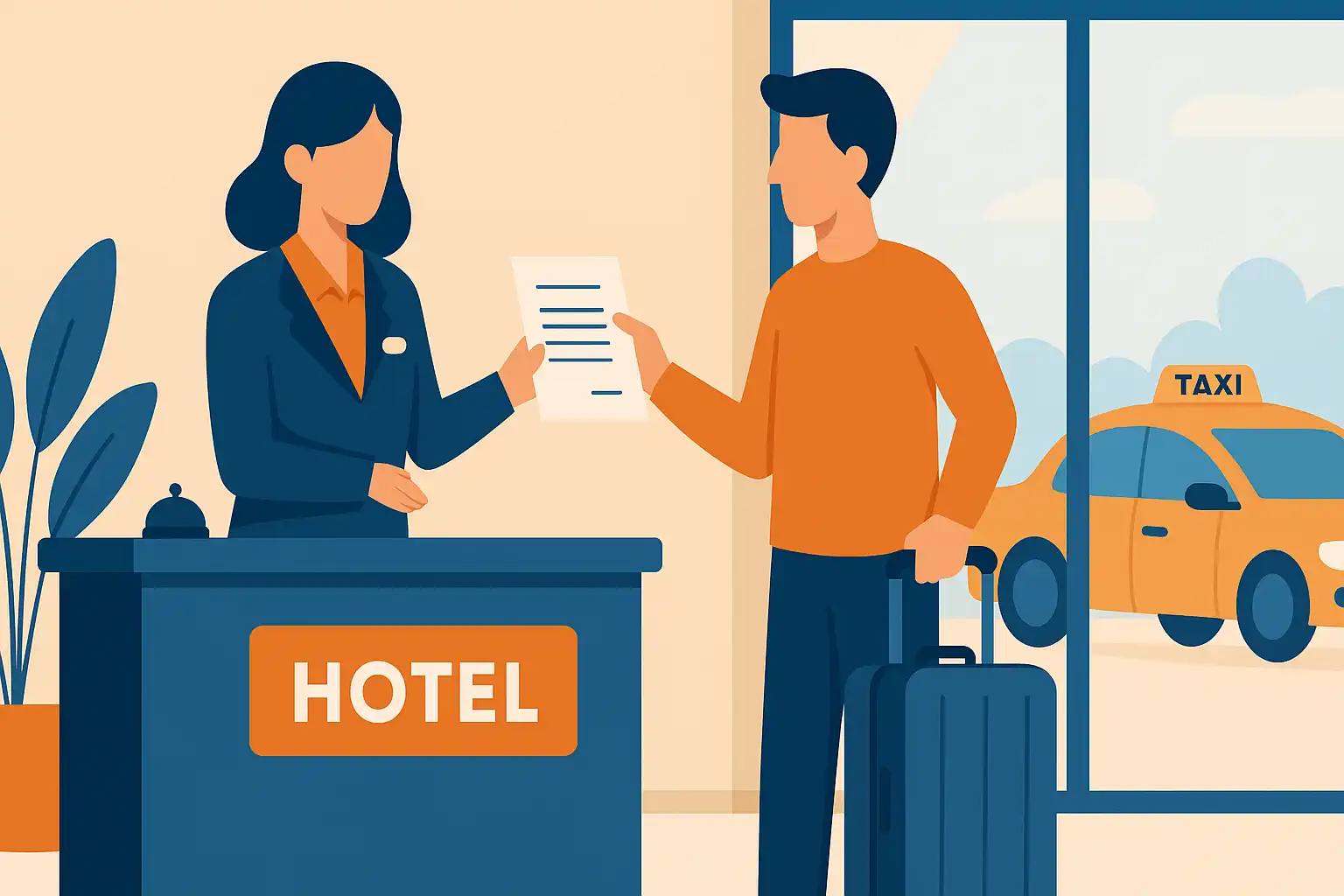
Hotel Walk Letter Template: Professional Guest Communication
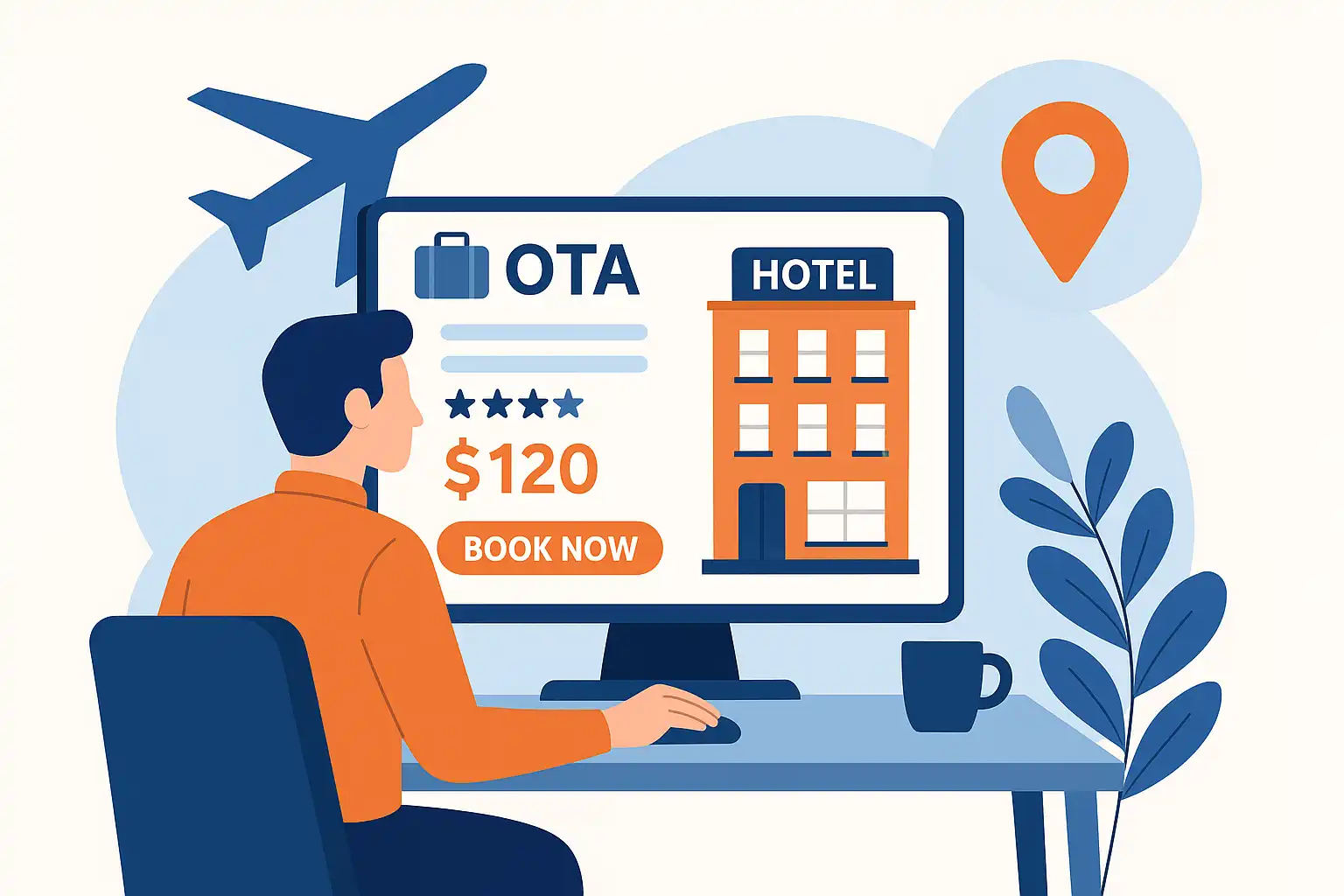
Online Travel Agents: What They Are and How They Work
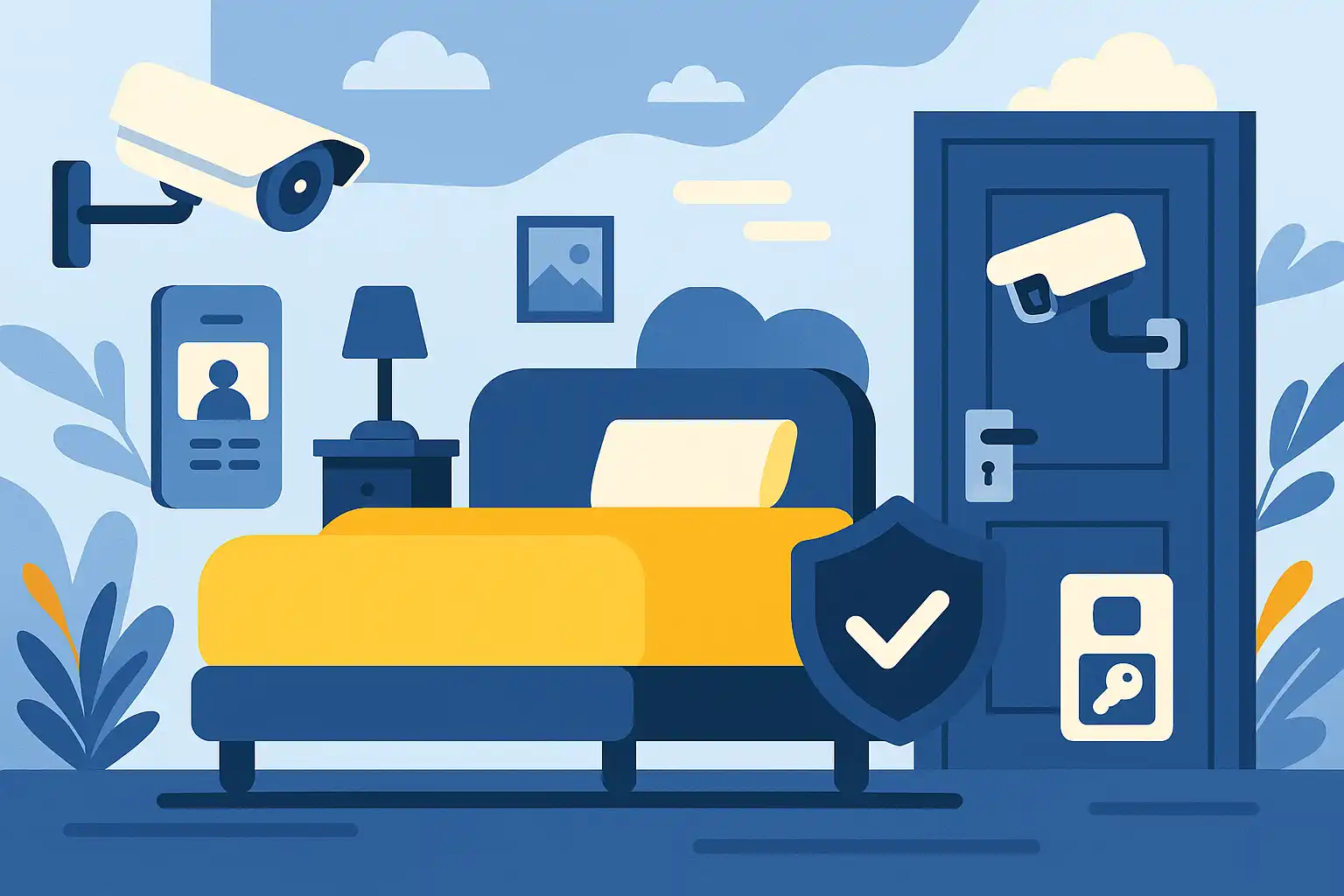
Hotel Security Systems: Modern Protection Solutions

Hotel Advertising: Complete Guide to Boost Bookings and Revenue
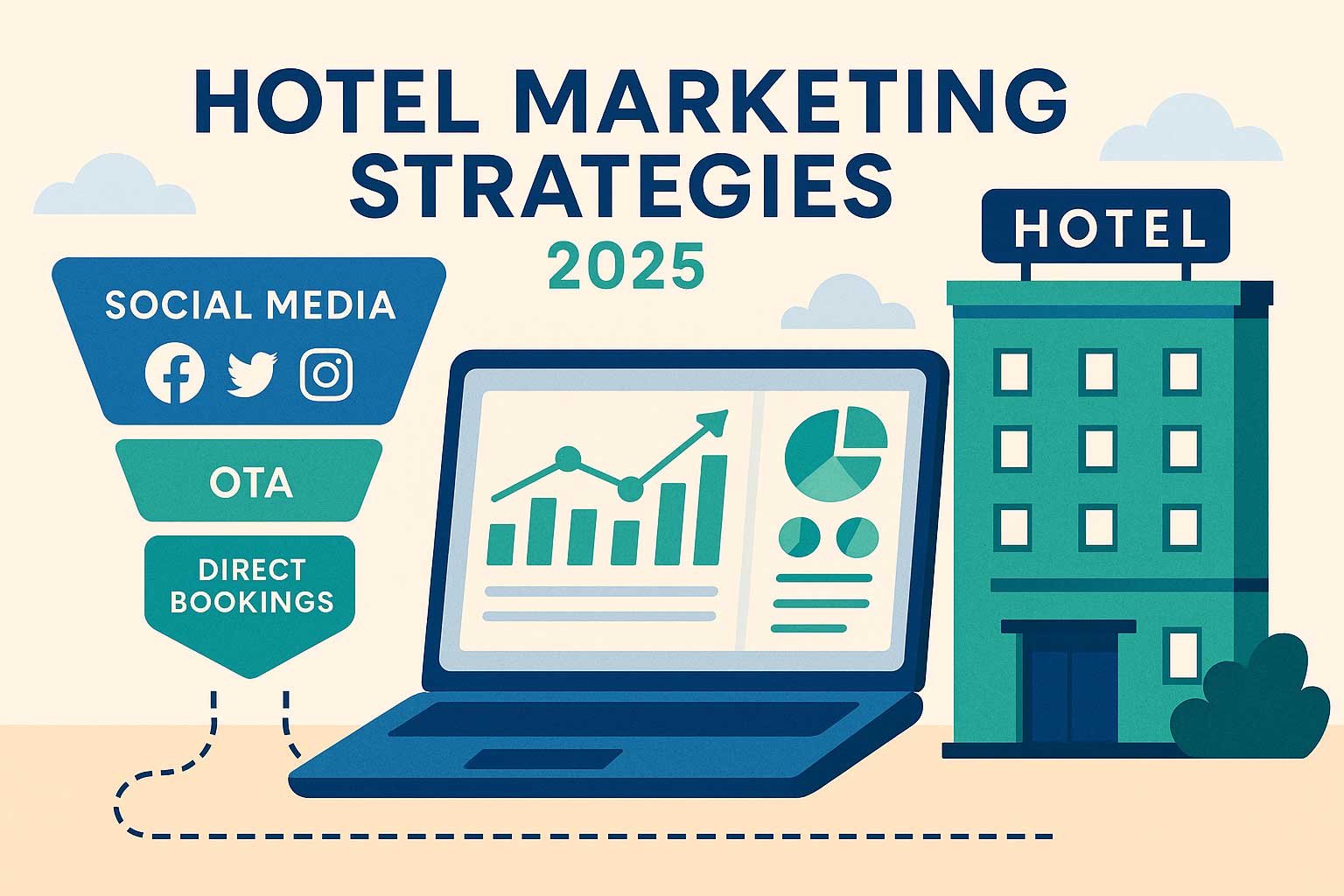
25 Hotel Marketing Strategy Ideas for 2025: Complete Guide

AI Reservation Agent: Revolutionizing Hotel Booking and Guest Experience

PMS Communication: Streamlining Property Management Through Effective Guest Messaging
Table of contents
In today’s bustling hospitality world, nearly 93% of hotel bookings kick off with an online search. Yet, many hotel owners find themselves scratching their heads trying to figure out the real costs and effectiveness behind their guest acquisition efforts. With online travel agencies (OTAs) charging commissions that can soar up to 25%, and digital marketing expenses steadily climbing, mastering hotel guest acquisition isn’t just smart—it’s essential for keeping your business profitable and thriving.
Hotel guest acquisition isn’t just about listing rooms online and hoping for the best. It’s a dynamic, interconnected process involving multiple distribution channels, savvy marketing strategies, tech investments, and operational costs—all of which directly influence your bottom line. The hotels that flourish are often those who truly understand, track, and optimize these guest acquisition costs.
This guide is here to walk you through everything you need to know about hotel guest acquisition—from crunching the numbers on your true acquisition costs to rolling out strategies that bring in more direct bookings while trimming marketing expenses. Whether you’re running a cozy independent hotel or managing a portfolio of properties, you’ll find practical advice to sharpen your acquisition strategy and boost your profits.
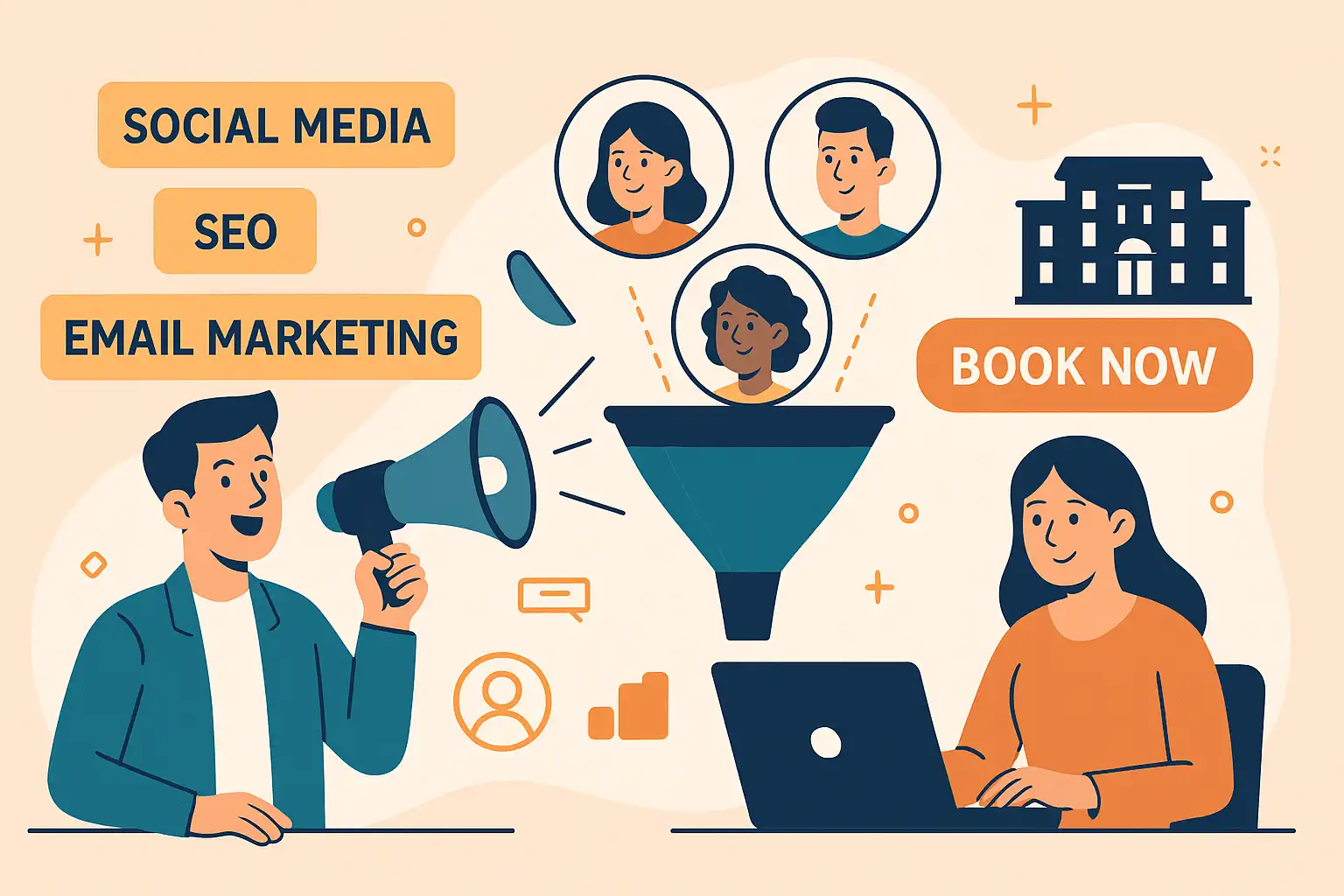
What is Hotel Guest Acquisition?
Simply put, hotel guest acquisition is the art and science of attracting and converting new guests to book stays at your hotel. This involves a mix of marketing, sales, and distribution channels working together. Unlike guest retention—which focuses on keeping your existing customers coming back—acquisition zeroes in on welcoming first-time visitors to your property.
Think of guest acquisition as a journey that starts with making potential guests aware of your hotel, then guiding them through consideration, booking, and even post-stay engagement. At the awareness stage, travelers might find you through search engines, OTAs, social media, or word of mouth. During consideration, they weigh your hotel against others, read reviews, and check out amenities. Booking is the exciting moment when prospects become guests, and post-stay engagement lays the groundwork for future visits.
Today’s hotel guest acquisition happens across many touchpoints all at once. A guest might spot your hotel on Google Hotels, compare prices on Booking.com, peek at reviews on TripAdvisor, visit your website, and finally book through your direct booking engine. This complexity makes tracking costs and pinpointing where bookings come from a challenge—but it’s absolutely vital for making smart decisions.
Guest acquisition is the lifeblood of hotel business growth. Without a steady stream of new guests, even the best retention efforts can’t keep occupancy healthy as guest bases naturally ebb and flow due to changing travel trends, life events, and competition. Smart acquisition strategies help reduce reliance on costly distribution channels and build valuable guest data for future marketing.
The hospitality industry faces unique challenges here. Unlike retail or subscription services where customers buy frequently, hotel stays are often rare and seasonal. Hotels must constantly attract fresh guests while competing with thousands of others. Plus, the high price tags on bookings mean guests are choosier, so winning their trust takes finesse and nurturing.
Understanding Guest Acquisition Costs (GAC)
Guest Acquisition Cost (GAC) is the total amount you spend to bring in each new guest booking. This includes marketing, distribution, technology, and operational expenses tied directly to turning prospects into paying customers. Keeping a close eye on your GAC is crucial because it affects your profitability and shows which channels give you the best bang for your buck.
Here’s the basic GAC formula:
Guest Acquisition Cost = Total Acquisition Costs ÷ Number of Guests Acquired
For example, if you spend $10,000 on acquisition efforts in a month and welcome 200 new guests, your GAC is $50 per guest.
You can also look at it as a percentage of your revenue:
GAC Percentage = (Total Acquisition Costs ÷ Total Room Revenue) × 100
So, if those guests brought in $40,000, your GAC percentage would be 25%.
Typically, guest acquisition costs hover between 15-30% of total room revenue, but this depends on your hotel’s type, location, and market position. Luxury hotels usually sit at the higher end because of longer sales cycles and pricier marketing, while budget spots might keep it leaner.
Independent hotels often face steeper acquisition costs than big chains since they don’t have the same marketing muscle or loyalty programs. But they also enjoy more freedom to negotiate commission rates and get creative with their acquisition tactics.
Tracking your guest acquisition cost helps you allocate your marketing budget wisely, optimize channels, and fine-tune pricing. Without this insight, you might unknowingly pour money into unprofitable channels or miss scaling your best performers. Plus, regular GAC reviews reveal seasonal trends so you can plan your budget smarter throughout the year.
A common pitfall? Focusing only on occupancy rates while ignoring acquisition costs. You might hit 90% occupancy thanks to heavy OTA promotions, but if those bookings come with a 40% GAC, you could be losing money on each stay. That’s why GAC deserves equal attention alongside your revenue metrics.

Types of Guest Acquisition Costs
Guest acquisition costs cover a broad range of expenses across departments and operations. Many hotels underestimate the full picture by only counting obvious costs like ad spend, missing out on tech fees, staff salaries, and indirect overheads.
Direct costs are those you can clearly link to acquisition—like advertising, OTA commissions, and booking engine fees. Indirect costs include shared expenses like salaries, technology infrastructure, and general operations that support acquisition efforts. Both matter for a full GAC view.
Tracking these costs often involves allocating shared expenses based on usage. For example, if your marketing team spends 60% of their time on acquisition, 60% of their salaries should be counted in acquisition costs.
Distribution and Channel Costs
Distribution channels usually take up 40-60% of acquisition expenses. These costs vary widely depending on your mix and negotiated rates, so optimizing channels can make a big difference.
OTA commissions typically run 15-25% of room revenue. Booking.com and Expedia lead the pack, often charging 18-20% base rates, but total costs can spike to 25-30% with promotions and transaction fees. Many hotels find their actual OTA expenses are higher than they expect due to these extras.
Metasearch platforms like Google Hotels, Trivago, and TripAdvisor use Cost-Per-Click (CPC) or Cost-Per-Stay (CPS) models. Google Hotels’ CPS fees range from 8-15%, making them a cost-effective way to drive traffic directly to your site, where you keep guest data.
Global Distribution Systems (GDS) cater to travel agents and corporate bookers, charging around 20% commissions. These bookings often have higher average daily rates, which can offset the costs. Business travelers booked via GDS tend to spend more and cancel less.
Direct booking engines usually cost 2-5% per booking in fees and payment processing, making them the most budget-friendly channel. But remember, you’ll need to invest in marketing to drive traffic there, so include those costs in your calculations.
Marketing and Advertising Expenses
Hotel digital marketing is a growing slice of acquisition budgets—often 30-50%. Search engine marketing, social ads, and display campaigns require ongoing spend to keep your hotel visible and attract qualified guests.
Google Ads for hotels typically cost $2-8 per click, depending on competition and keywords. High-intent searches like “hotels in [destination]” command premium prices. Independent hotels might spend $5,000-$20,000 monthly on Google Ads alone.
Search Engine Optimization (SEO) is a longer-term play that can slash acquisition costs over time. Hotels investing in SEO often see organic traffic jump 20-40% within a year or so, easing reliance on paid ads. Content creation, technical tweaks, and link building all count as acquisition costs.
Email marketing platforms cost $200-$2,000 monthly depending on list size and complexity. While email mainly supports retention, acquisition-focused campaigns targeting past visitors and lookalikes should be included.
Social media marketing includes paid ads and content creation. Facebook and Instagram ads typically cost $1-4 per click, but conversion rates vary. Influencer partnerships, especially with micro-influencers, are gaining traction for their high engagement at reasonable costs.
Technology and Infrastructure Costs
Tech supporting acquisition—like websites, booking engines, and channel managers—can be 10-20% of your total acquisition spend. These often fly under the radar because they’re bundled with PMS fees or paid annually.
Maintaining a sleek hotel website with booking functionality might cost $3,000-$15,000 a year, covering hosting, security, updates, and optimization.
Channel manager subscriptions help distribute your inventory across many platforms while keeping rates in sync. These typically run $100-$500 monthly, depending on property size and channels connected. Advanced features might cost more but can improve acquisition efficiency.
Property Management Systems (PMS) charge per room monthly fees ($2-$8), with 20-30% of that supporting acquisition-related features.
Customer Relationship Management (CRM) and marketing automation tools help personalize communications and track campaign performance. Costs range from $50 to $500 monthly, with premium platforms offering AI-powered insights.
Personnel and Operational Costs
People costs—marketing teams, sales pros, revenue managers, and customer service reps—often make up 20-40% of acquisition expenses.
Allocate salaries based on time spent on acquisition activities. For example, if a marketing manager earns $60,000 annually and spends 70% of their time on acquisition, $42,000 counts toward acquisition costs.
Sales teams handling corporate and group bookings usually earn $50,000-$100,000 plus commissions and require longer sales cycles but bring in higher revenue per booking.
Revenue managers focus partly on acquisition by optimizing pricing and distribution, typically earning $45,000-$80,000 annually, with 30-50% of their work supporting acquisition.
Customer service costs include labor and tech tools for booking support. Larger hotels may have dedicated reservations staff, while smaller ones might share duties across management.
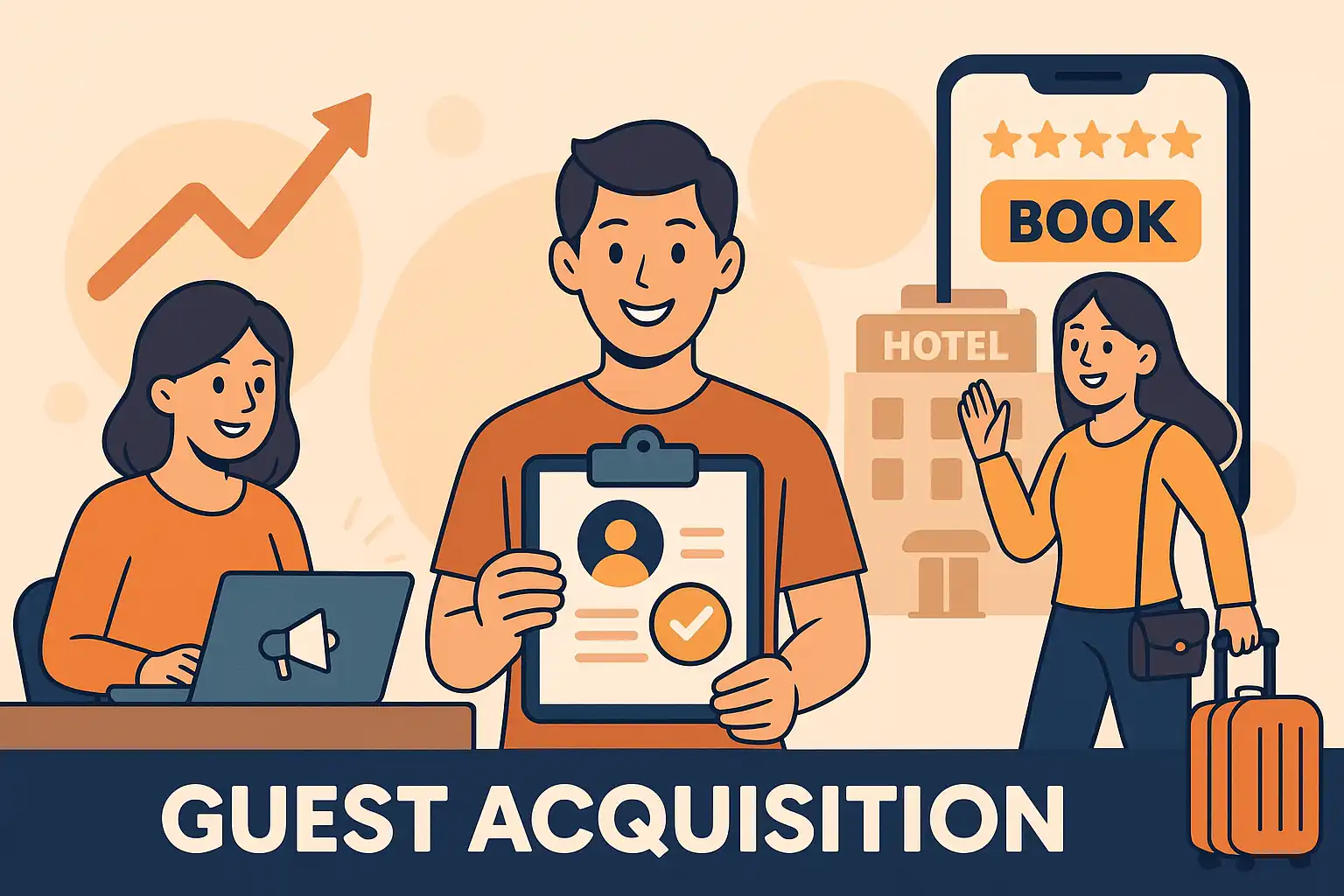
Hotel Guest Acquisition Channels
Today’s hotel guest acquisition happens across a rich mix of channels, each with its own costs, audiences, and performance traits. Knowing how these channels work helps you build a balanced strategy that cuts costs and boosts revenue.
Relying too heavily on one channel is risky. OTAs can hike commissions or tweak algorithms; direct bookings might struggle to reach new audiences during busy seasons.
Guests behave differently depending on channel. Business travelers often book through corporate or GDS channels valuing convenience, while leisure guests compare OTAs before deciding. Tailoring your channel mix and messaging to these behaviors pays off.
When evaluating channels, look beyond acquisition cost. Consider guest lifetime value, cancellation rates, and extra spending. Sometimes a pricier channel brings more long-term value through loyal guests and referrals.
Online Travel Agencies (OTAs)
OTAs still dominate hotel distribution, handling 40-50% of online bookings worldwide. Platforms like Booking.com, Expedia, and Agoda offer huge reach but come with hefty costs and trade-offs.
Booking.com charges 15-18% base commissions, but total costs often hit 20-25% with promotions and fees. Their massive marketing muscle makes them great for exposure, especially for independents without big brand names. But those commissions can eat into your profits.
Expedia’s commissions vary from 10-25% depending on platform and promotions. Their wide portfolio lets hotels tap multiple audiences through one partnership, though managing inventory across Expedia brands requires care.
OTAs bring benefits beyond bookings: they invest billions in advertising and customer acquisition, effectively subsidizing your marketing. They also offer targeting tools to reach specific demographics or regions.
Downsides include high commissions, limited guest data access, and less control over the booking experience. Guests often see OTAs as the main relationship, not your hotel, which can hurt loyalty.
Best practices? Keep rate parity but offer perks for direct bookings, manage promotions carefully, and negotiate commissions annually based on performance.
Direct Booking Channels
Direct bookings are your most profitable source, costing just 2-7% compared to OTAs’ 15-25%. This includes your hotel website with booking engine, phone reservations, and emails that bypass third parties.
A well-optimized website with a modern booking engine offers low acquisition costs and high conversions. Features like real-time availability, dynamic pricing, mobile-friendly design, and upsells can boost booking value by 10-20%. The tech investment usually pays off within a year through commission savings.
Direct bookings also mean full guest data ownership, letting you personalize marketing, enroll guests in loyalty programs, and communicate directly. You control the whole guest journey, creating stronger brand bonds.
Mobile optimization is key—over 60% of hotel searches come from phones now. Mobile-responsive sites and smooth booking processes can lift conversion rates 20-40%. Features like saved payment info and social media integration help, too.
To drive direct bookings, offer rate parity with OTAs but throw in exclusive perks like free WiFi, breakfast, or upgrades. Loyalty programs designed to encourage repeat business can lower future acquisition costs by turning one-time guests into regulars. Email campaigns targeting past guests often convert 5-10 times better than general ads.
SEO plays a big role here, improving organic visibility and cutting paid ad reliance. Hotels that invest in SEO often see organic traffic jump 30-50% in 18 months, slashing direct booking acquisition costs. Local SEO is especially important since many travelers use location-specific searches.
Metasearch Platforms
Hotel metasearch sites like Google Hotels, Trivago, and TripAdvisor let travelers compare prices from multiple sources, often sending them to your site for booking. This helps you compete with OTAs while keeping guest data.
Google Hotels dominates here, showing up in Google searches and capturing lots of hotel queries. They use a Cost-Per-Stay (CPS) model charging 8-15% fees only on completed bookings, often cheaper than pay-per-click ads.
Trivago mainly uses Cost-Per-Click (CPC), where hotels bid for top spots. This means upfront costs regardless of bookings, but offers precise budget control and usually lower acquisition costs than OTA commissions. Success requires smart bidding and landing page optimization.
Metasearch’s big advantage is supporting direct bookings and guest data ownership. Unlike OTAs, you get full guest details for future marketing, boosting lifetime value and cutting future acquisition costs.
These platforms level the playing field, letting independents compete with big brands by offering competitive prices and showcasing unique perks. But you need real-time pricing, smooth booking engines, and great user experiences to win metasearch traffic.
Corporate and Group Channels
Corporate and group bookings often come with higher average daily rates and longer stays, making them valuable despite higher acquisition costs and longer sales cycles. These include GDS platforms, direct corporate contracts, and group sales via event planners.
GDS platforms like Sabre and Amadeus connect hotels with travel agents and business travelers, charging about 20% commissions. But these bookings tend to have premium rates, generate extra revenue from services like dining and meetings, and have lower cancellations.
Direct corporate contracts involve negotiating rates and terms with companies for regular business travel. These partnerships take effort but can be very profitable long-term. Corporate guests often book extras and influence leisure travel choices.
Group sales for weddings, conferences, or retreats require specialized skills and longer lead times but bring big revenue from multiple rooms and services. The total revenue often justifies higher acquisition costs and dedicated sales teams.
Business travel management companies centralize bookings for large organizations, offering steady volume and simpler account management compared to individual contracts.
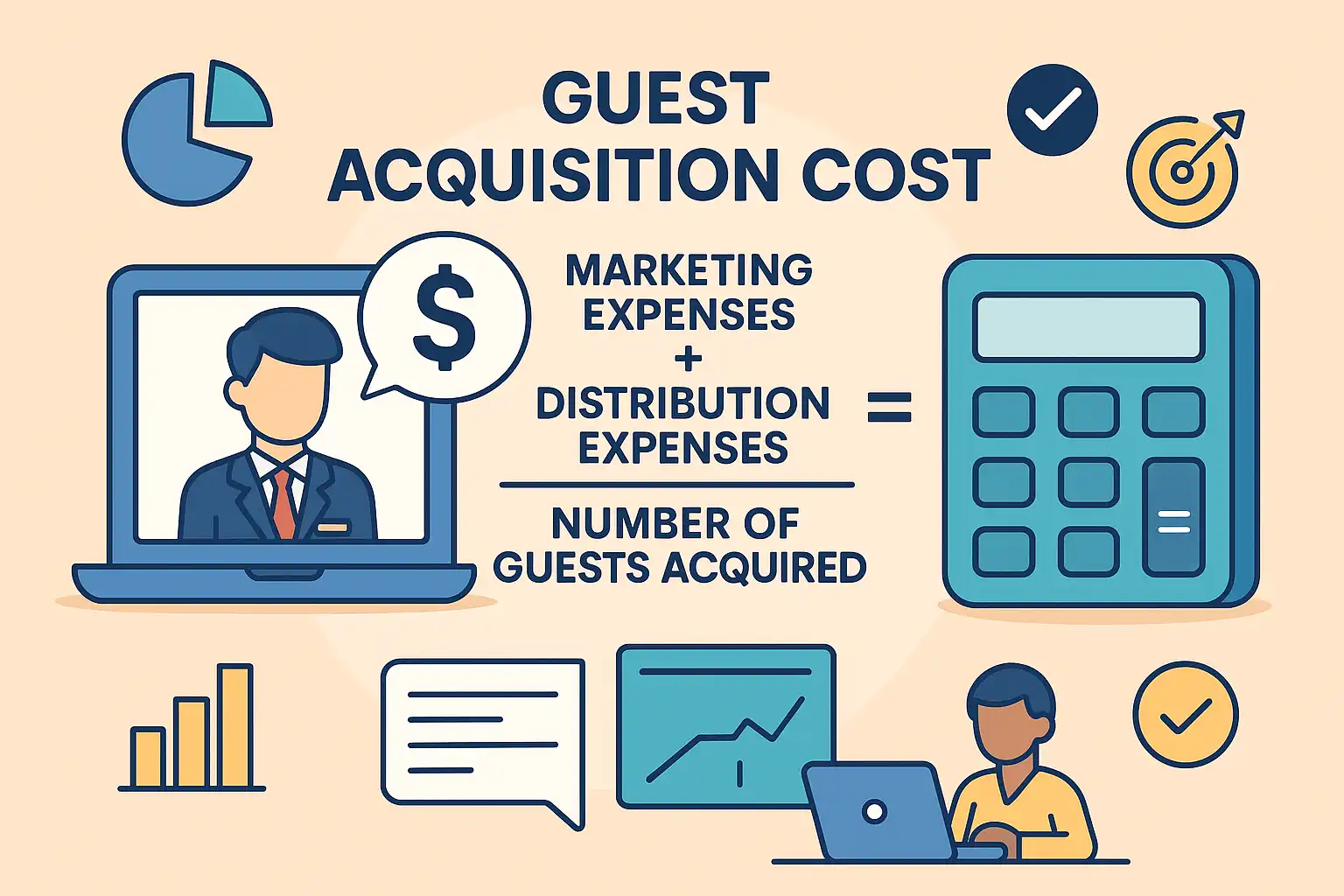
How to Calculate and Track Guest Acquisition Cost
To track GAC effectively, set up clear methods, gather all relevant data, and review regularly for actionable insights. Many hotels struggle here due to inconsistent measurement or missing cost categories.
Start by categorizing all direct and allocated costs tied to acquisition. Advertising and OTA commissions are easy; staff time and tech infrastructure need estimates based on usage.
Monthly calculations strike the right balance between detail and stability. Weekly may be too jumpy; quarterly might miss trends. Many hotels calculate monthly and review quarterly.
Breaking down GAC by channel shows which sources give the best ROI and where to optimize. Sometimes pricier channels pay off with higher guest lifetime value and extra revenue.
Here’s a simple step-by-step example:
Step 1: Gather Monthly Acquisition Expenses
- OTA commissions: $8,500
- Google Ads: $2,200
- Metasearch fees: $1,800
- Website and booking engine: $400
- Marketing staff allocation (60% of $4,000): $2,400
- Email marketing: $150
- Social media ads: $600
- SEO and content creation: $800
- Total: $16,850
Step 2: Count New Guests Acquired
- Total new bookings: 220
- Repeat bookings: 55
- New guests: 165
Step 3: Calculate GAC
- $16,850 ÷ 165 = $102.12 per new guest
Step 4: Calculate GAC Percentage
- Total room revenue from new guests: $58,500
- ($16,850 ÷ $58,500) × 100 = 28.8%
This hotel’s GAC fits industry norms but could cut costs by reducing OTA reliance, which makes up over half of their acquisition spend.
Remember, GAC fluctuates seasonally—expect 20-40% swings between peak and off-peak due to competition and ad costs. Tracking these helps you budget and adjust marketing smartly.
Set benchmarks based on your hotel’s type and market. Luxury spots might run 25-35%, budget hotels 15-25%, depending on strategy.
Tech can simplify GAC tracking. Many PMS and marketing platforms offer built-in analytics to monitor acquisition costs by channel, saving time and boosting insights.
Strategies to Optimize Hotel Guest Acquisition
Optimizing guest acquisition means balancing cost cuts with booking volume and guest quality. The best strategies improve multiple channels together rather than just shifting budget around.
Start by analyzing performance beyond costs—look at guest lifetime value, booking habits, cancellations, and extra spending. Sometimes spending more upfront pays off long-term with loyal guests.
Testing and measurement are key. Run A/B tests on website elements, ads, and channels to find what really works. Keep detailed records to spot winners.
Segment your guests to tailor marketing. Business travelers, families, couples, and groups respond differently, so customize your messages and channels.
Reducing Direct Channel Acquisition Costs
Direct bookings offer the biggest savings because you control the experience and tech. Boosting your website’s conversion rate by 10-20% can slash acquisition costs dramatically.
Start with website speed—slow pages kill bookings. Aim for under 3 seconds load time, especially on mobile. Optimize images, use content delivery networks, and simplify booking flows.
Invest in SEO to cut paid ad dependence. Hotels often see organic traffic jump 30-50% in a year, lowering direct booking costs. Local SEO is especially powerful.
Use email marketing automation to nurture past visitors and target lookalike audiences. Booking abandonment emails can recover 10-15% of lost sales. Personalized campaigns outperform generic promos by 20-30%.
Social media builds relationships and cuts paid ad reliance. Focus on platforms your audience loves. User-generated content, influencer partnerships, and community-building can generate bookings at lower costs.
Loyalty programs encourage repeat direct bookings and lower future acquisition costs by turning one-time guests into regulars. Simple perks like upgrades or late checkout often work better than complex point systems.
Optimizing Paid Channel Performance
Paid channels need constant tuning. Regularly analyze and adjust bids to boost efficiency by 15-25% and lower costs.
Negotiate OTA commissions using data on booking volume, guest satisfaction, and revenue. Good performance can earn you better rates or promo terms.
Manage metasearch budgets carefully. Use automated bidding that adapts to occupancy, seasonality, and competition. Set max cost-per-stay targets but allow flexibility during busy times.
Refine Google Ads by focusing on long-tail keywords, optimizing ad copy, and improving landing pages. Use negative keywords to avoid wasted spend.
Test ads and landing pages systematically—small improvements in click or conversion rates can cut acquisition costs significantly.
Adjust campaigns seasonally. What works in peak season might flop off-peak. Use historical data to plan budgets and channel mixes.
Leveraging Guest Data for Acquisition
Analyzing guest data sharpens your targeting and cuts acquisition costs. Build buyer personas from booking, spending, and demographics.
Segment guests by behavior and preferences to create targeted campaigns that convert better and cost less.
Create lookalike audiences on social media and Google using your best guests’ profiles. These campaigns often double or triple conversion rates at lower cost.
Use personalized retargeting to recover 10-20% of abandoned bookings with tailored messages. Dynamic ads showing specific rooms and prices work best.
Manage reviews and reputation actively to boost organic rankings and booking confidence. High ratings reduce paid ad reliance.
Referral programs turn happy guests into acquisition channels by rewarding recommendations. These programs can generate 5-15% of bookings at minimal cost.
Balancing Guest Acquisition and Retention
Acquisition and retention go hand in hand for long-term success. It costs about five times more to get a new guest than to keep one, so retention is key to lowering future acquisition costs.
Calculate guest lifetime value (LTV) based on stay frequency, spend, and relationship length to set smart acquisition budgets.
Shifting 20-30% of acquisition budget to retention can improve overall marketing ROI.
Your ideal mix depends on your hotel’s age, market, and goals. New hotels need more acquisition; established ones benefit from retention focus.
Even with great retention, natural guest attrition means steady acquisition is necessary.
Align messaging and marketing across acquisition and retention for a seamless guest experience that builds loyalty and attracts new guests.
Here’s a quick look at acquisition vs. retention:
| Metric | Guest Acquisition | Guest Retention |
|---|---|---|
| Average Cost | $50-150 per guest | $10-30 per guest |
| Conversion Rate | 2-5% | 15-25% |
| Revenue Timeline | Immediate | Ongoing |
| Data Requirements | External research | Internal database |
| Success Measurement | Bookings generated | Repeat visit frequency |
| Marketing Channels | Broad reach required | Direct communication |
Evaluate acquisition alongside retention to spot opportunities. High acquisition but low retention may signal service issues that need fixing before spending more.
Loyalty programs bridge acquisition and retention—attracting new guests and encouraging repeat stays. Referral incentives turn loyal customers into advocates.
Revenue management should consider both acquisition costs and LTV when setting prices and promos. Dynamic pricing that factors in acquisition helps balance profit and competitiveness.
Tech integrations between acquisition and retention systems enable marketing automation that nurtures guests through every stage, personalizing offers and communication.
Long-term success means balancing growth with profitability. Too much focus on acquisition can hurt profits; too little can cause decline.
Conclusion
Mastering hotel guest acquisition means understanding the complex dance of costs, channels, and strategies that drive profitable bookings in today’s competitive hospitality industry. The winners are those who track their true acquisition costs, optimize their channel mix, and balance acquisition with retention to maximize guest lifetime value.
The secret sauce? Knowing every cost—from OTA commissions to tech fees and staff salaries—and using data to find smarter, more cost-effective ways to bring in guests.
Diversify your channels to spread risk and seize opportunities. Blend direct bookings with optimized OTA partnerships and explore new paths like metasearch and social commerce.
The future will keep evolving with tech and traveler habits. Hotels investing in data analytics, personalization, and direct booking optimization—while nurturing strong distribution relationships—will thrive.
Start today: audit your acquisition costs, calculate your GAC, spot your most and least profitable channels, and craft strategies that fit your unique property and market. Small tweaks in acquisition efficiency can lead to big wins in profitability and long-term success.
